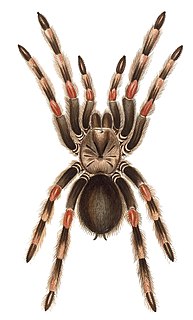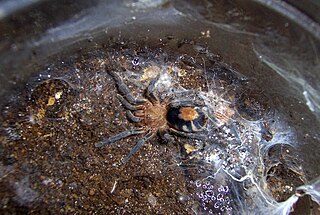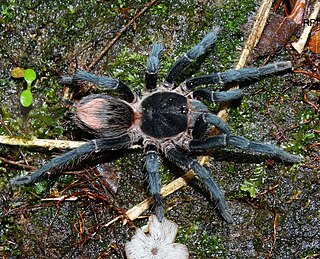
Avicularia is a genus of the family Theraphosidae containing various species of arboreal tarantulas. The genus is native to tropical Central and South America. Each species in the genus has very distinguishable pink foot pads.

Brachypelma is a genus of spiders in the family Theraphosidae (tarantulas). They may have bodies up to 6 cm long with legs of similar or greater lengths. Some species have brightly colored legs, with red or orange marks and rings.

Brachypelma smithi is a species of spider in the family Theraphosidae (tarantulas) native to Mexico. It has been confused with Brachypelma hamorii; both have been called Mexican redknee tarantulas. Mexican redknee tarantulas are a popular choice as pets among tarantula keepers. Many earlier sources referring to B. smithi either relate to B. hamorii or do not distinguish between the two species. B. smithi is a terrestrial tarantula native to Pacific coast of the Mexican state of Guerrero.

Pamphobeteus is a genus of tarantulas that was first described by Reginald Innes Pocock in 1901. It includes some of the largest spiders in the world.

Psalmopoeus is a genus of the family Theraphosidae containing various species of tarantulas. The genus is native to Central America and South America including the West Indies. These species are believed to be relatively venomous, and research in the venom of P. cambridgei shows it to be similar to capsaicin, the molecule causing irritation in chili peppers. These molecules activate sensory cells to send pain signals to the brain. Genetic engineers are working on blocking the receptors that are activated by these molecules.

Poecilotheria metallica, also known as the peacock tarantula, is an Old World species of tarantula. It is the only blue species of the genus Poecilotheria. Like others in its genus it exhibits an intricate fractal-like pattern on the abdomen. The species' natural habitat is deciduous forest in Andhra Pradesh, in central southern India. It has been classified as Critically endangered by the IUCN.

Tarantulas comprise a group of large and often hairy spiders of the family Theraphosidae. Currently, 1,010 species have been identified. The term "tarantula" is usually used to describe members of the family Theraphosidae, although many other members of the same infraorder (Mygalomorphae) are commonly referred to as "tarantulas" or "false tarantulas". Some of the more common species have become popular in the exotic pet trade. Many New World species kept as pets have setae known as urticating hairs that can cause irritation to the skin, and in extreme cases, cause damage to the eyes.
Neischnocolus is a genus of spiders in the family Theraphosidae. It was first described in 1925 by Petrunkevitch. The genus Ami was separately described in 2008, but was later discovered to be a junior synonym of Neischnocolus. Species are native to Central America and northern South America.

Cyriocosmus is a genus of tarantulas that was first described by Eugène Louis Simon in 1903.

Brachypelma albiceps is a species of spider in the tarantula family, Theraphosidae. It is known as the Mexican golden red rump tarantula or the Amula red rump tarantula. The carapace is a light golden color and the abdomen dark, covered with long red hairs. Females typically live for about 15 years. Males usually live about 5 years or up to 12 months after the last molt.

Poecilotheria striata, or the Mysore ornamental tarantula, is a large arboreal tarantula of the family Theraphosidae. It is endemic to India.
Hapalotremus is a genus of South American tarantulas in the Theraphosinae subfamily that was first described by Eugène Louis Simon in 1903. They have red or white Type III urticating hairs, up to 1.2 millimetres (0.047 in), with a fine point and barbs along at least half of the lower part. The tibial apophysis is branched twice, and there is a conspicuous subapical keel on the male's embolus.

Homoeomma is a genus of South American tarantulas that was first described by Anton Ausserer in 1871. It is considered a senior synonym of Calopelma, Butantania, and of Cyclothoracoides.

Megaphobema is a genus of tarantulas that was first described by Reginald Innes Pocock in 1901. They look similar to members of Pamphobeteus except for its legs; the third and fourth pairs of legs are much larger and stronger than the first two pairs.
Melognathus is a monotypic genus of southeast Asian tarantulas containing the single species, Melognathus dromeus. It was erected in 1917 for a holotype collected from a ship that visited southeast Asia. In 1985, the species was moved to Cyriopagopus because the autapomorphies were not considered significant enough to warrant a new genus. Opinions between biologists were split, some using the original name and some using Cyriopagopus. In a 2019 report, Gabriel and Sherwood pointed out that in addition to the differences in pedipalp morphology, the holotype exhibits leg features that indicate an arboreal species, while species of Cyriopagopus are largely terrestrial. The ambiguous location of the holotype has left room for speculation, but as of February 2022 the World Spider Catalog accepts this genus.
Rick C. West is a Canadian arachnologist with a main expertise toward tarantula spiders. West was born in Victoria, British Columbia. He has been interested in spiders since childhood, and collected his first tarantula, Aphonopelma eutylenum at the age of 13. He worked primarily as a Chief Constable for a local Animal Humane Society, but also have been involved with the collecting, breeding, rearing and photography of theraphosid spiders. West has traveled to over 27 countries to document and study them in their environment, has been a host, presenter and co-producer in several tarantula documentaries and has also described several new species.

The Selenocosmiinae are a subfamily of tarantulas found throughout South-East Asia and Australia. This subfamily is defined by the presence of a lyra on the maxillae and strikers on the chelicerae, allowing these spiders to stridulate and produce a "hissing" sound. However some species within Phlogiellus may have secondary lost their lyra but retain their strikers. The monophyly of the subfamily has been only tested using genetic data with a handful of genera or species in a few studies. However, these studies found genera that had been previously placed in this subfamily were actual their own separate subfamily (Poecilotheria) and that Selenocosmiinae is most closely related to the Indian Thrigmopoeinae. As of 2021, Selenocosmiinae contains 11 genera.

Tliltocatl is a genus of North American tarantulas that was split off from Brachypelma in 2020. They are also large burrowing tarantulas, but don't have the striking red leg markings of Brachypelma species. A female T. vagans can grow up to 50 mm (2.0 in) long and legs can get as long as 55 mm (2.2 in). They are found predominantly in Mexico, with some species native to Central America. The name is derived from two Nahuatl words, "tlil", meaning "black", and "tocatl", meaning "spider". Habitat destruction and collection for the pet trade has led to this and Brachypelma to be protected under International Convention on International Trade of Endangered Species rules, beginning with B. smithi.
Spinosatibiapalpus is a genus of tarantulas erected by Gabriel and Sherwood in 2020 for a newly discovered species and two other previously described species bearing a unique palpal bulb morphology. The name is a reference to the spines found on the fourth section of the pedipalp in adult males. This distinctive feature was also found in Pseudhapalopus species, but because it is never mentioned in the original description of that genus, Gabriel and Sherwood called into question the validity of Pseudohapalopus, and moved all its species except P. aculeatus, known only from a single male found in Bolivia in 1907. It is impossible to place P. aculeatus because the holotype was destroyed when the museum housing it was bombed during World War II, and it has been declared as nomen dubium.
Pseudoclamoris burgessi is a tarantula in the Pseudoclamoris genus, it was first described by Martin Hüsser in 2018. It is found in Leticia, Colombia and Iquitos, Peru, although it is likely also found in Ecuador. It is named after Joseph Burges whom helped to collect important material for this study. It is fairly commonly breed and kept in captivity, with its common name being Ghost Tree Spider. As the name suggest it is an arboreal tarantula, and usually have a skittish behavior.













